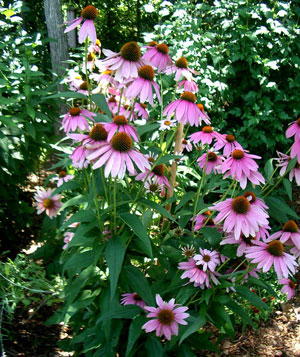Native Plants for Arkansas Wildlife
Searcy, Ark. –
 The key to providing quality habitat for many Arkansas wildlife species is establishing
a diversity of plants which provide year-round nutrition and cover for their survival.
Wildlife are adapted particularly to native plants that meet their habitat needs.
The key to providing quality habitat for many Arkansas wildlife species is establishing
a diversity of plants which provide year-round nutrition and cover for their survival.
Wildlife are adapted particularly to native plants that meet their habitat needs.
- Different plant parts are consumed seasonally - leaves, stems, seeds, buds, berries, or flowers.
- Trees, shrubs, and native grasses afford cover when wildlife is resting, nesting, brooding young, escaping from predators, and surviving cold winter temperatures.
- Plants which attract insects in the spring also attract wild turkey, songbirds, and bobwhites and their young, which require many insects during critical life stages.
With a good seed bank, all that is needed is soil disturbance, and maybe a little fertilizer and lime, to make an attractive native food plot which lures in deer, turkeys, bobwhites, and other wildlife. Results from statewide food plot demonstrations conducted by University of Arkansas county agents and faculty indicated wildlife consumed natural plants growing in disked and fertilized plots as much as those in traditional food plots. Which begs the question, why plant seeds when you can grow weeds?
How to Establish Native Plants
Small acreages. Yards and gardens with a diversity of plants become an important habitat source in residential areas.
Larger acreages. Native forbs and grasses can be established by creating disturbance through disking, prescribed fire, thinning trees, or other practices that give native plants the advantage.
Timing is everything. Exactly when these disturbances occur, and the types of plant species present in the seed bed results in different plant responses.
Plant responses do vary. Landowners who are willing to experiment can gain a better understanding about native plant responses to different practices implemented at different times of year.
Leased land. Hunting clubs leasing industrial or commercial forest lands may be restricted from disking, thinning trees, or prescribed fire. Planting grasses and forbs may be one of the few options allowed in a lease contract for providing patches of habitat and plant diversity. By cultivating particular plant types and seeding in strategic locations, viewing opportunities are improved. Hunters can draw wildlife into openings for selective harvest. Planting native seeds is an option, though finding a supplier can be difficult. The cost for native seeds tends to be higher than agricultural seeds, but once they are established, only periodic maintenance is required.
Not all plants sold for agricultural or landscape purposes are beneficial for wildlife.
Commercial seed producers and farmer co-ops provide products and services for agricultural production, and sometimes also market these same products to hunters for food plots.
Home and garden stores may market wildlife plantings for residential landscaping, but is it really your best choice? A particular seed may be readily available and easy to grow, but other factors to consider are:
- the quality and duration of food and cover the plant provides, and
- its invasive qualities.
Non-native plants which adapt to local climates and have no natural controls can quickly overtake a landscape and eliminate native plants. Sericea lespedeza, kudzu, and other invasive plant species were introduced to the U.S. in part for their wildlife qualities. The resulting negative environmental and economic impacts have far outpaced benefits from these once-touted plant species. Native plants can be invasive as well.
Make sure you know what you're planting!
It's always a good idea to investigate what you are planting first, before planting something you may later regret. The USDA PLANTS database is one resource for classifying native and non-native plants.
The University of Arkansas System, Division of Agriculture is an equal opportunity institution. For more information you can contact your local county extension service, you can also follow Sherri Sanders on Facebook @UAEX.WhiteCountyAgriculture .
###
By Sherri Sanders
County Extension Agent - Agriculture
U of A System Division of Agriculture
White County Cooperative Extension Service
2400 Old Searcy Landing Road Searcy AR 72143
(501) 268-5394
ssanders@uada.edu